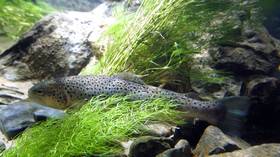Almost half of rivers contaminated by drugs – study

A shocking 43.5% of the world’s waterways are contaminated with drugs, according to a research team who published their findings on Wednesday in the journal Environmental Toxicology and Chemistry.
Led by the University of York’s Alejandra Bouzas-Monroy, the researchers analyzed 1,052 samples across 104 countries and found 23 separate pharmaceutical compounds at levels exceeding those considered “safe.” These included antidepressants, antihistamines, benzodiazepines, painkillers, and stimulants.
More than a third (34.1%) of the sites where multiple samples were taken had more than one location with drug concentrations found to be of “ecological concern.”
Bouzas-Monroy, who claimed the study was “the first global assessment” of pharmaceutical contamination in waterways, warned that humans should be “doing much more to reduce the emissions of these substances into the environment.”
The study took note not only of the drugs present in the water but of their effects on fish and aquatic vegetation. Drugs like the antidepressant amitriptyline and the antipsychotic carbamazepine, are known to change enzyme activity in fish, while the antidepressant citalopram and the tranquilizer diazepam both change behavior in the animals. The diabetes drug metformin alters sex hormone activity in fish, as does blood pressure drug propranolol. All were found in the waterways studied by Bouzas-Monroy and her team.
Pharmaceuticals end up in the water through the bodily waste produced by both humans and animals, as well as through runoff from pharmaceutical manufacturing facilities and farms. The US Geological Survey has been monitoring the problem in the US since 2002, when it found at least seven chemicals in over half the waterways it tested. In 2019, the agency found similar levels of contamination in a sample of 1,120 wells and streams used as a source of drinking water.
Bouzas-Monroy’s study also mentioned the high levels of non-pharmaceutical contamination plaguing the world’s waterways, from industrial chemicals and pesticides to heavy metals like lead.
Many US water utilities do not even test for pharmaceuticals, since the long-term health effects of consuming trace amounts of such drugs on humans or animals have not been adequately studied. Even when the effects of a pharmaceutical contaminant on local wildlife are widely known and acknowledged, there may be little motivation in the surrounding community to act.
Fluoxetine, the generic name of popular antidepressant Prozac, is a common waterway contaminant (found in several of the samples studied by Bouzas-Monroy) that causes marked behavioral changes in fish, rendering them less sexually aggressive and less motivated to hunt for food. The effect may linger as long as three generations, meaning populations remain affected long after any cleanup takes place.
And even when contaminants are known to cause harm to humans, as with the high levels of lead and other metals in and around Flint, Michigan, cleanup can take years, if it happens at all.














